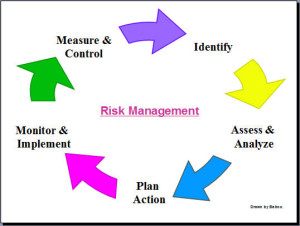The Basics of Risk Management
November 13, 2012 - 6 minutes read Simply stated, the aim of risk management is to reduce the chances of people being harmed in some way from hazards within an organisation. Not only should good risk management reduce the risk of harm, but it should also help keep liability claims and insurance costs under control.
Simply stated, the aim of risk management is to reduce the chances of people being harmed in some way from hazards within an organisation. Not only should good risk management reduce the risk of harm, but it should also help keep liability claims and insurance costs under control.
When it comes to risk management for churches, it’s important to note that there is no one-size for all as every organisation is unique and has its own combination of hazards and risks. However there is a basic procedure that can be followed:
- Hazard identification.
- Risk assessment or evaluation.
- Risk control measures.
- Recording of findings.
- Monitoring and reviewing.
Hazard identification
Hazards are basically those things that have the potential to cause personal harm (injury, illness or disease) in an organisation. When we consider hazards, we might tend to think of physical objects that could cause someone to fall or to trip over. While these are very real hazards, they are not the only element that could cause harm in an organisation.
Types of hazard include:
- Physical – slip, trip and fall hazards such as cables, slippery floors, buckled floor coverings, heights, and pot-holes. Physical hazards can also include objects that could fall and strike someone such as files, books or folders on shelving.
- Job-based – including work tasks that could lead to muscle strain – such as repetitive actions, poor lifting and carrying techniques, and over-stretching.
- Electricity – the potential for ignition, burns, and shocks.
- Machinery – mechanical hazards such as moving parts, and cutting, crushing and entanglement areas.
- Chemicals and dust – which may lead to respiratory problems or burns.
- Biological – viruses, dust particles and bacteria.
- Psycho-social – includes excess work stress and fatigue, bullying, harassment, and unresolved conflict.
- Other – such as temperature extremes, poor lighting, excessive noise, and radiation.
In a church-based setting many of the above may not apply, especially in the case of some of the smaller congregations. However it’s important for all churches to conduct hazard identification in order to take note of any particular significant hazards present on their own premises.
Risk Assessment or evaluation
The next step involves determining the likelihood of the hazard causing harm to someone, as well as the type of harm and its potential severity. Another issue to consider is how the hazard might cause harm – for instance, you might want to look at the number of people who could be exposed to the hazard, or if a chain reaction could occur that might lead to one failure escalating into something more serious.
Risk control
This step basically involves determining what can be done to reduce the risk of harm. In some cases this may involve complete removal of the hazard. In other cases elimination of the hazard might not be an option and steps should be taken to minimise the risk of harm as much as possible. This may include such measures as doing repairs, providing protective equipment, improving workstation design, reducing hazard exposure, or purchasing extra fire-safety equipment. In addition, if the risk of harm is very low, it may not be necessary for any action to take place at all.
Recording of all findings and conducting reviews
Recording your findings and keeping track of any incidents of harm is an important step. It enables you to evaluate and review your risk control program later on, and determine whether hazards are being properly dealt with and your control measures are working. In a smaller church it may not be necessary to record the findings, and in fact there is no legal obligation to do so unless there are five or more employees in the organisation. However it’s a good idea for all church organisations to keep written records even if they are not complex and involved. This could be done by developing your own checklists, or making use of online tools.
To assist you in identifying hazards and controlling risks, we have uploaded a number of church risk assessment and management forms on the CCI website. These can be accessed from here – simply scroll down to find the form you require.
And finally…
A Risk Management Officer induction for essential safety measures can be done at our website training page here. This induction takes about 10 minutes and is designed for RMOs (Risk Management Officers) or designated persons in charge of Redbook. More information and resources on risk assessment and control can also be found at the State WorkSafe site, or through Safe Work Australia.
Written by Tess Oliver
Tags: asset protection, health & safety, risk management
Recent Comments